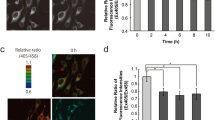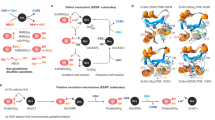Abstract
It has long been assumed that the oxidized form of glutathione, the tripeptide glutamate–cysteine–glycine, is a source of oxidizing equivalents needed for the formation of disulphide bonds in proteins within the endoplasmic reticulum (ER), although the in vivo function of glutathione in the ER has never been studied directly. Here we show that the major pathway for oxidation in the yeast ER, defined by the protein Ero1, is responsible for the oxidation of both glutathione and protein thiols. However, mutation and overexpression studies show that glutathione competes with protein thiols for the oxidizing machinery. Thus, contrary to expectation, cellular glutathione contributes net reducing equivalents to the ER; these reducing equivalents can buffer the ER against transient hyperoxidizing conditions.
This is a preview of subscription content, access via your institution
Access options
Subscribe to this journal
Receive 12 print issues and online access
$209.00 per year
only $17.42 per issue
Buy this article
- Purchase on Springer Link
- Instant access to full article PDF
Prices may be subject to local taxes which are calculated during checkout







Similar content being viewed by others
References
Meister, A. Glutathione metabolism and its selective modification. J. Biol. Chem. 263, 17205–17208 ( 1988).
Hwang, C., Sinskey, A. J. & Lodish, H. F. Oxidized redox state of glutathione in the endoplasmic reticulum. Science 257, 1496– 1502 (1992).
Hoober, K. L., Joneja, B., White, H. B. III & Thorpe, C. A sulfhydryl oxidase from chicken egg white. J. Biol. Chem. 271, 30510–30516 (1996).
Creighton, T. E. et al. On the biosynthesis of bovine pancreatic trypsin inhibitor (BPTI). Structure, processing, folding and disulphide bond formation of the precursor in vitro and in microsomes. J. Mol. Biol. 232, 1176–1196 (1993).
Ohtake, Y. & Yabuuchi, S. Molecular cloning of the gamma-glutamylcysteine synthetase gene of Saccharomyces cerevisiae. Yeast 7, 953–961 (1991).
Frand, A. R. & Kaiser, C. A. The ERO1 gene of yeast is required for oxidation of protein dithiols in the endoplasmic reticulum. Mol. Cell 1, 161–170 ( 1998).
Pollard, M. G., Travers, K. J. & Weissman, J. S. Ero1p: a novel and ubiquitous protein with an essential role in oxidative protein folding in the endoplasmic reticulum. Mol. Cell 1, 171–182 ( 1998).
Endrizzi, J. A., Breddam, K. & Remington, S. J. 2.8-Å structure of yeast serine carboxypeptidase . Biochemistry 33, 11106– 11120 (1994).
Jämsä, E., Simonen, M. & Makarow, M. Selective retention of secretory proteins in the yeast endoplasmic reticulum by treatment of cells with a reducing agent. Yeast 10, 355–370 ( 1994).
Simons, J. F., Ferro-Novick, S., Rose, M. D. & Helenius, A. BiP/Kar2p serves as a molecular chaperone during carboxypeptidase Y folding in yeast. J. Cell. Biol. 130, 41– 49 (1995).
Cherest, H., Thomas, D. & Surdin-Kerjan, Y. Cysteine biosynthesis in Saccharomyces cerevisiae occurs through the transsulfuration pathway which has been built up by enzyme recruitment. J. Bacteriol. 175, 5366 –5374 (1993).
Ono, B. et al. Cysteine biosynthesis in Saccharomyces cerevisiae: mutation that confers cystathionine beta-synthase deficiency. J. Bacteriol. 170, 5883–5889 ( 1988).
Oluwatosin, Y. E. & Kane, P. M. Mutations in the CYS4 gene provide evidence for regulation of the yeast vacuolar H+-ATPase by oxidation and reduction in vivo. J. Biol. Chem. 272, 28149–28157 ( 1997).
Paszewski, A. & Ono, B. I. Biosynthesis of sulphur amino acids in Saccharomyces cerevisiae: regulatory roles of methionine and S-adenosylmethionine reassessed. Curr. Genet. 22, 273– 275 (1992).
Richman, P. G. & Meister, A. Regulation of gamma-glutamyl-cysteine synthetase by nonallosteric feedback inhibition by glutathione. J. Biol. Chem. 250, 1422– 1426 (1975).
Cox, J. S., Shamu, C. E. & Walter, P. Transcriptional induction of genes encoding endoplasmic reticulum resident proteins requires a transmembrane protein kinase. Cell 73, 1197–1206 ( 1993).
Kohno, K., Normington, K., Sambrook, J., Gething, M. J. & Mori, K. The promoter region of the yeast KAR2 (BiP) gene contains a regulatory domain that responds to the presence of unfolded proteins in the endoplasmic reticulum. Mol. Cell. Biol. 13, 877–890 (1993).
Sidrauski, C., Cox, J. S. & Walter, P. tRNA ligase is required for regulated mRNA splicing in the unfolded protein response. Cell 87, 405–413 (1996).
Schmidt, M., Grey, M. & Brendel, M. A microbiological assay for the quantitative determination of glutathione. Biotechniques 21, 884– 886 (1996).
Kosower, N. S. & Kosower, E. M. Diamide: an oxidant probe for thiols. Methods Enzymol. 251, 123–133 (1995).
Kobayashi, T. et al. Respiratory chain is required to maintain oxidized states of the DsbA- DsbB disulfide bond formation system in aerobically growing Escherichia coli cells. Proc. Natl Acad. Sci. USA 94, 11857–11862 (1997).
Kurjan, J. & Herskowitz, I. Structure of a yeast pheromone gene (MF alpha): a putative alpha-factor precursor contains four tandem copies of mature alpha-factor. Cell 30, 933– 943 (1982).
Chandler, M. L. & Varandani, P. T. Kinetic analysis of the mechanism of insulin degradation by glutathione-insulin transhydrogenase (thiol: protein-disulfide oxidoreductase). Biochemistry 14, 2107–2115 (1975).
Gilbert, H. F. Catalysis of thiol/disulfide exchange: single-turnover reduction of protein disulfide-isomerase by glutathione and catalysis of peptide disulfide reduction . Biochemistry 28, 7298– 7305 (1989).
Adams, A., Gottschling, D. E., Kaiser, C. A. & Stearns, T. Methods in Yeast Genetics: A Cold Spring Harbor Laboratory Course Manual (Cold Spring Harb. Lab. Press, Cold Spring Harbor, 1998).
Burns, N. et al. Large-scale analysis of gene expression, protein localization, and gene disruption in Saccharomyces cerevisiae. Genes Dev. 8, 1087–1105 ( 1994).
Liu, H., Krizek, J. & Bretscher, A. Construction of a GAL1-regulated yeast cDNA expression library and its application to the identification of genes whose overexpression causes lethality in yeast. Genetics 132, 665–673 (1992).
Jones, J. S. & Prakash, L. Yeast Saccharomyces cerevisiae selectable markers in pUC18 polylinkers. Yeast 6, 363–366 (1990).
Anderson, M. E. Determination of glutathione and glutathione disulfide in biological samples . Methods Enzymol. 113, 548– 555 (1985).
Guarente, L. Yeast promoters and lacZ fusions designed to study expression of cloned genes in yeast. Methods Enzymol. 101, 181– 191 (1983).
Sikorski, R. S. & Hieter, P. A system of shuttle vectors and yeast host strains designed for efficient manipulation of DNA in Saccharomyces cerevisiae. Genetics 122, 19–27 (1989).
Acknowledgements
We thank H. Ploegh for anti-CPY antibody; R. Sauer and A. Frand for helpful discussions and critical reviews of this manuscript; and all members of the Kaiser laboratory for help and suggestions throughout the course of this project. This work was supported by a grant from the National Institutes of General Medical Sciences (GM46941). J. W. C. was supported by an NIH National Research Service Award (GM18715).
Correspondence and requests for materials should be addressed to C.A.K.
Author information
Authors and Affiliations
Corresponding author
Rights and permissions
About this article
Cite this article
Cuozzo, J., Kaiser, C. Competition between glutathione and protein thiols for disulphide-bond formation. Nat Cell Biol 1, 130–135 (1999). https://doi.org/10.1038/11047
Received:
Revised:
Accepted:
Published:
Issue Date:
DOI: https://doi.org/10.1038/11047
This article is cited by
-
Crosstalk between endoplasmic reticulum stress and oxidative stress in the progression of diabetic nephropathy
Cell Stress and Chaperones (2021)
-
Ca2+ mobilization-dependent reduction of the endoplasmic reticulum lumen is due to influx of cytosolic glutathione
BMC Biology (2020)
-
Ultra-rapid glutathionylation of chymotrypsinogen in its molten globule-like conformation: A comparison to archaeal proteins
Scientific Reports (2020)
-
Molecular Mechanisms of ER Stress and UPR in the Pathogenesis of Alzheimer’s Disease
Molecular Neurobiology (2020)
-
Reductive stress in striated muscle cells
Cellular and Molecular Life Sciences (2020)



